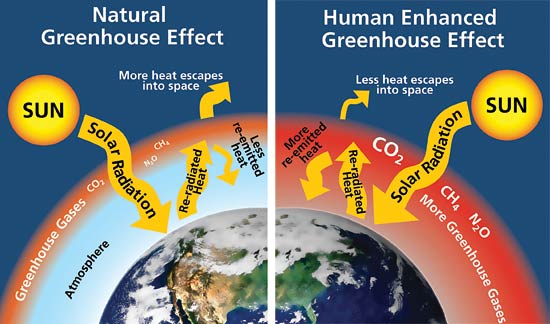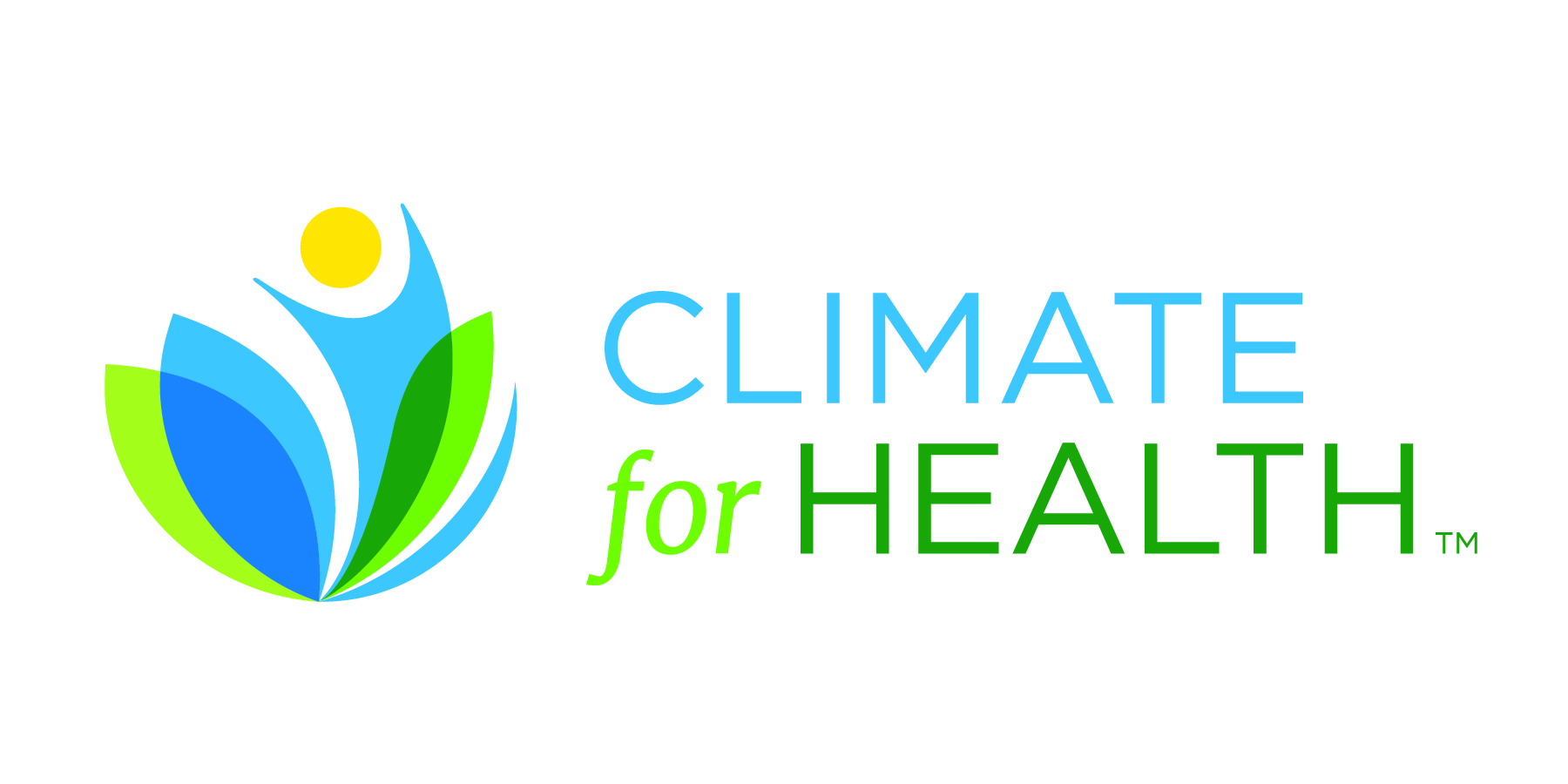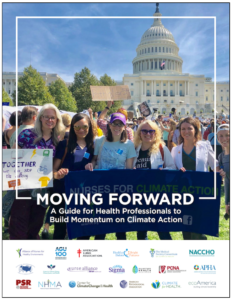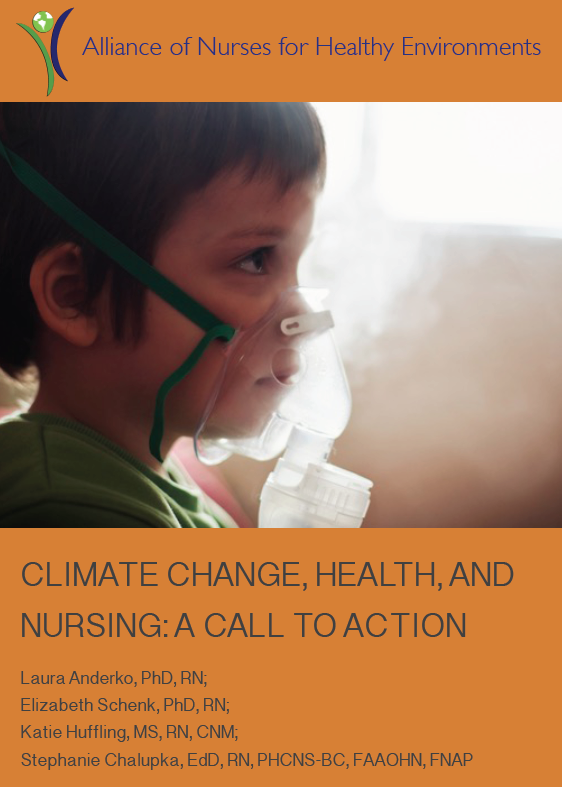Climate Change & Health
 The effects of climate change over the coming years are anticipated to pose a significant threat to public and environmental health, with certain areas already experiencing environmental and health effects linked to this crisis. It is estimated that the Earth’s temperature over the last century has increased 1.5 degrees Fahrenheit, with projections only increasing in coming centuries[i]. The rise in Earth’s temperature, resulting from emissions and elevated concentrations of greenhouse gases in the atmosphere, is contributing to a changing climate. Human activity, such as burning fossil fuels for energy production and use, transportation, industry (including healthcare), and agriculture have resulted in unprecedented levels of greenhouse gas emissions such as methane, carbon dioxide, and nitrous oxide. The science is clear that human activity is the dominant cause of Earth’s rising temperature and without immediate action irreversible damage is likely.[ii]
The effects of climate change over the coming years are anticipated to pose a significant threat to public and environmental health, with certain areas already experiencing environmental and health effects linked to this crisis. It is estimated that the Earth’s temperature over the last century has increased 1.5 degrees Fahrenheit, with projections only increasing in coming centuries[i]. The rise in Earth’s temperature, resulting from emissions and elevated concentrations of greenhouse gases in the atmosphere, is contributing to a changing climate. Human activity, such as burning fossil fuels for energy production and use, transportation, industry (including healthcare), and agriculture have resulted in unprecedented levels of greenhouse gas emissions such as methane, carbon dioxide, and nitrous oxide. The science is clear that human activity is the dominant cause of Earth’s rising temperature and without immediate action irreversible damage is likely.[ii]
As a result of rising temperatures, changing and variable weather patterns are occurring, such as extreme temperatures both heat and cold, rising sea levels from melting of snow and ice, changes in precipitation resulting in flooding and drought, more intense hurricanes and storms, stronger and more frequent wildfires, as well as poor air quality. Changes to climate patterns lead to direct and indirect threats to public and environmental health.
Nurses’ Role in Addressing Climate Change

 The Alliance of Nurses for Healthy Environments has partnered with ecoAmerica (eA) and Climate for Health (CfH) in supporting the Nursing Collaborative on Climate Change and Health which aims to bring together nursing organizations to elevate nursing leadership in addressing climate change. With support by national organizations representing nurses across differing specialties, there is great potential to bring a health-focused discussion to national climate change policy, regulations, and initiatives. The Nursing Collaborative’s aim is to inspire nurses to be leaders in helping our patients, our communities, and our healthcare institutions engage in climate change mitigation activities and in preparing for potential effects of climate change. If your organization would like to join the Nursing Collaborative please contact Cara Cook at cara@enviRN.org. For individual nurses that would like to take action, join us in the Nurses Climate Challenge! The Nurses Climate Challenge is a national campaign to mobilize nurses to educate 50,000 health professionals on the impacts of climate change on human health.
The Alliance of Nurses for Healthy Environments has partnered with ecoAmerica (eA) and Climate for Health (CfH) in supporting the Nursing Collaborative on Climate Change and Health which aims to bring together nursing organizations to elevate nursing leadership in addressing climate change. With support by national organizations representing nurses across differing specialties, there is great potential to bring a health-focused discussion to national climate change policy, regulations, and initiatives. The Nursing Collaborative’s aim is to inspire nurses to be leaders in helping our patients, our communities, and our healthcare institutions engage in climate change mitigation activities and in preparing for potential effects of climate change. If your organization would like to join the Nursing Collaborative please contact Cara Cook at cara@enviRN.org. For individual nurses that would like to take action, join us in the Nurses Climate Challenge! The Nurses Climate Challenge is a national campaign to mobilize nurses to educate 50,000 health professionals on the impacts of climate change on human health.
Resources
- Climate for Health’s Moving Forward: A Guide for Health Professionals to Build Momentum on Climate Action
- Let’s Talk Climate and Health: 1 hour of nursing CE credit for webinar by Bob Perkowitz, CEO of ecoAmerica (eA) and Climate for Health (CfH)
- Mental Health and Our Changing Climate: Impacts, Implications, and Guidance report
- US Climate Action Network Video and Workbook – Advancing Clean Air, Climate, & Health: Opportunities for Nurses (3 CEs)
- Four-part webinar series sponsored by ecoAmerica and the American Public Health Association that discusses the health impacts of climate change
- Moms Clean Air Force and ANHE have created a brochure for health professionals that outlines steps for advocating for clean air and family’s health.
Climate Change and Health
 Greenhouse gas emissions and subsequent pollution have resulted in changes to the climate that contribute to negative health impacts. Health impacts include increases in infectious disease transmission risk, extreme weather event related morbidity and mortality, and reductions in food supply and displacement of populations as a result of increases in flooding and droughts.[iii] There are also significant consequences associated with air quality deterioration resulting from burning fossil fuels, coal combustion, and increasing levels of pollutants, ground-level ozone, and particulate matter. Increased carbon emissions contribute to worsening rates of heart disease, cancer, stroke, chronic respiratory disease and asthma, and elevated atmospheric levels of ozone and particulate matter are associated with increased vulnerability to respiratory and cardiovascular diseases, premature death, and preterm birth.[iv]
Greenhouse gas emissions and subsequent pollution have resulted in changes to the climate that contribute to negative health impacts. Health impacts include increases in infectious disease transmission risk, extreme weather event related morbidity and mortality, and reductions in food supply and displacement of populations as a result of increases in flooding and droughts.[iii] There are also significant consequences associated with air quality deterioration resulting from burning fossil fuels, coal combustion, and increasing levels of pollutants, ground-level ozone, and particulate matter. Increased carbon emissions contribute to worsening rates of heart disease, cancer, stroke, chronic respiratory disease and asthma, and elevated atmospheric levels of ozone and particulate matter are associated with increased vulnerability to respiratory and cardiovascular diseases, premature death, and preterm birth.[iv]
Certain populations will be extremely vulnerable to health impacts associated with climate changes including children, the elderly, low-income populations, and individuals with chronic health conditions. Due to systemic racism and historical policies that have contributed to racial inequity in the United States and globally make it so some communities of color will be disproportionately harmed by climate and health impacts. Further, with the range of climate regions across the United States, climate change will pose variable risks throughout the country. This is why it is critical that racial and economic justice and the centering of communities most harmed by climate is central to climate policy and solutions.
Refer to ANHE’s 2016 report titled “Climate Change, Health, and Nursing: A Call to Action” for a further review of the science of climate change and relation to health, specific health impacts by U.S. region, and more information on how nurses can get involved in addressing this issue. Check out the Climate & Health 101 resource page of the ANHE Climate and Health Toolkit to learn more.
Resources:
The National Institute of Environmental Health Sciences’ website lists the health impacts of climate change, along with strategies to reduce health impacts, and identifies areas for further research.
The Centers for Disease Control and Prevention’s website lists the effects of climate on health and provides fact sheets to use for further education.
The Intergovernmental Panel on Climate Change works to advance understanding of climate change and impacts by reviewing and assessing current scientific, technical and socio-economic information. View their latest full assessment report here and an IPCC special report on the impacts of global warming of 1.5 °C above pre-industrial levels and related global greenhouse gas emission pathways, in the context of strengthening the global response to the threat of climate change, sustainable development, and efforts to eradicate poverty here.
The Fourth National Climate Assessment, a report developed by over 300 experts and a Federal Advisory Committee, details the impacts of climate change across the differing regions of the United States.
Review the 2019 report of The Lancet Countdown on health and climate change: ensuring that the health of a child born today is not defined by a changing climate and accompanying policy brief for the United States here.
The World Health Organization’s website identifies what is being done on a global level to address the threat of climate change and offers actions to take to advance climate solutions.
Learn how to apply health promotion interventions in caring for the planet and the systems in which human existence depends at the Planetary Health Alliance.
Climate Change and Nursing is a video series to introduce you to the health threats posed by climate change and the associated actions that nurses can take, and to consider the ethical obligation of nurses to act on their knowledge.
Climate Change Adaptation and Mitigation: Action for Nurses
Adoption of both climate adaptation and mitigation strategies are necessary to protect the health of the public against the negative impacts of climate change. Climate adaptation strategies include preparing for and responding to threats posed by climate change, whereas mitigation strategies aim to eliminate or reduce threats. Adaptation strategies are necessary to ensure community and healthcare institution preparedness in adapting and responding to impacts resulting from climate change. Mitigation is necessary to halt further warming of the Earth and worsening climate patterns.
To ensure communities and healthcare facilities are prepared for impacts of climate change, including natural disasters and flooding, nurses can work with local and state health departments and healthcare facilities to ensure that disaster preparedness plans and training are in place in the event of disruption in community infrastructure or health services. Nurses can further facilitate the development of statewide climate adaptation plans and action plans for extreme temperature events to ensure that people have access to necessary care.
There is still a great amount of work to be done in the healthcare sector to mitigate the effects of climate change. The healthcare industry accounts for almost 10% of the total greenhouse gas emissions in the United States.[v] Nurses can work within institutions to reduce the use of fossil fuels by promoting energy efficiency in operations and building design, along with encouraging the use of clean energy when possible. Hospitals can utilize purchasing power to purchase healthy and environmentally sustainable foods to serve to staff and patients to promote health and reduce their carbon footprint.
Further areas to address climate and health impacts needing nursing involvement include developing assessment tools to assess environmental impacts on health, assisting in research efforts to further the science on climate and health, and furthering education of fellow nurses, health professionals, patients, policy makers, and the public on climate change and strategies to reduce impacts. Nurses can also advocate for public-health backed policy and ensure that health is placed at the forefront of decision making as it relates to climate and health. Learn more about what nurses can do to address climate change through the ANHE Climate and Health Toolkit.
Resources
Join the global movement of nurses around the globe taking action to decrease greenhouse gas emissions and create a healthier future at Nurses Drawdown.
Utilize the Climate Change and Renal Health: Awareness and Education Toolkit for Healthcare Providers by Christie Torres, MSN, RN, APRN, FNP-BC, a toolkit to increase professional awareness and knowledge of climate change, including risk factors, signs and symptoms, social determinants of health, and patient quality of care issues.
View the Climate and Health Alliance’s discussion paper that proposes a thematic framework for a National Strategy for climate, health and well-being, which includes six key action areas.
The Lancet Countdown: Tracking Progress on Health and Climate Change, an international research collaboration, dedicated to tracking the world’s response to climate change.
Health Care Without Harm and Practice Greenhealth’s report “Addressing Climate Change in the Health Care Setting: Opportunities for Action” discusses how healthcare settings can implement changes to address and mitigate the effects of climate change.
“Healthy Hospitals, Healthy Planet, Healthy People: Addressing Climate Change in Healthcare Settings” is a report developed by the World Health Organization and Health Care Without Harm that discusses the impact of the healthcare sector on climate change and identifies solutions that facilities can take to reduce their carbon footprint.
The CDC’s Building Resilience Against Climate Effects (BRACE) framework provides a planning process for health officials to develop and put into place preparedness strategies for communities to protect against climate and health threats.
The Georgetown Climate Center has complied information on the status of state and local adaptation plans in the U.S. and discusses the progress made in carrying out plans by state.
Project Drawdown the world’s leading resource for climate solutions.
How to Communicate about Climate and Health
In order to convey the message of how climate change affects health and the urgency to act now to prevent worsening impacts, nurses should understand how to effectively communicate with patients, colleagues, policy makers, and the public. It is important to frame your message around how climate change will affect human and public health, rather than focusing solely on the changes to the environment. It is also essential to focus not only on the problem, but to offer solutions to how the issue can be addressed through education on adaptation and mitigation strategies. There are numerous resources available to assist nurses and other health professionals with communicating about climate and health. Here are a few resources to get you started on opening up the conversation:
Let’s Talk Climate and Health: Communication Guidance for Health Professionals by ecoAmerica and Climate for Health
Conveying the Human Implications of Climate Change: A Climate Change Primer for Health Professionals by George Mason University, Center for Climate Change Communication
Yale Program on Climate Change Communication
References
[i] United States Environmental Protection Agency. (2017). Climate change: Basic information. Retrieved from https://19january2017snapshot.epa.gov/climatechange/climate-change-basic-information_.html#main-content
[ii] International Panel on Climate Change. (2014). Climate change 2014 synthesis report: Summary for policymakers. Retrieved from https://www.ipcc.ch/report/ar5/syr/
[iii] Adlong, W., & Dietsch, E. (2015). Nursing and climate change: An emerging connection. Collegian, 22(1), 19-24.
[iv] Allen, P.J. (2015). Climate change: A review of potential health consequences. Primary Health Care, 25(7), 34-40.
[v] Eckelman, M.J. & Sherman, J. (2016). Environmental impacts of the U.S. health care system and effects on public health. PLOS ONE, 11(6), 1-14. https://doi.org/10.1371/journal.pone.0157014

